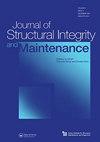桥梁和管道冲刷监测主动测温技术的最新进展,以及探索性被动测温研究
IF 3.1
Q2 ENGINEERING, CIVIL
Journal of Structural Integrity and Maintenance
Pub Date : 2023-04-03
DOI:10.1080/24705314.2023.2165471
引用次数: 1
摘要
摘要本文综述了主动测温技术在桥梁和管道冲刷监测中的应用,并通过室外桶式静态冲刷实验探索了被动测温的潜力。主动测温使用一种设备来提供热量,然后监测温度损失。热量产生通常通过电阻(焦耳)加热,使用数字温度传感器、光纤温度传感器和热敏电阻测量温度。文献中的所有实验室研究都是在静态条件下进行的,其中通过使用放置在桥墩(或管道)上的传感器监测热特性的变化来检测冲刷的开始和进展。本研究中探索的被动测温方案包括使用DS18b20数字温度传感器测量水中和三种沉积物类型(粘土、沙子和砾石)的温度变化。结果表明,水中的日变化大于沉积物中的日变化。位于沉积物中的传感器与水中的传感器通过检查在有限数量的日循环中获得的不同温度波形之间的递减率和相移的组合来区分。本文章由计算机程序翻译,如有差异,请以英文原文为准。
A state-of-the-art review of active-thermometry techniques for bridge and pipeline scour monitoring, and exploratory passive thermometry studies
ABSTRACT This paper reviews the application of active thermometry techniques for bridge and pipeline scour monitoring, and explores the potential for passive thermometry through outdoor bucket-type static scour experiments. Active thermometry uses a device to supply heat and then monitors temperature loss. The heat generation is typically through resistive (joule) heating, and temperature is measured using digital temperature sensors, fiber optic temperature sensors, and thermistors. All laboratory studies in the literature were conducted in static conditions, in which the onset and progression of scour are detected by monitoring the changes in thermal properties using sensors placed along the bridge pier (or pipeline). The passive thermometry option explored in this study involved using DS18b20 digital temperature sensors to measure temperature variations in water and in three sediment types: clay, sand, and gravel. The results demonstrated larger diurnal variations in water than in the sediments. Sensors located in the sediment were distinguished from those in water by examining a combination of decrement ratios and phase shifts among the different temperature waveforms obtained for a finite number of diurnal cycles.
求助全文
通过发布文献求助,成功后即可免费获取论文全文。
去求助
来源期刊

Journal of Structural Integrity and Maintenance
ENGINEERING, CIVIL-
CiteScore
3.90
自引率
9.50%
发文量
24
 求助内容:
求助内容: 应助结果提醒方式:
应助结果提醒方式:


